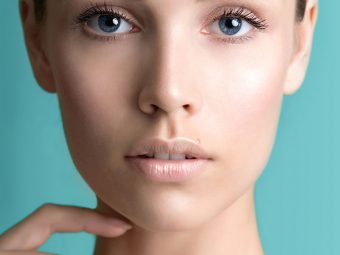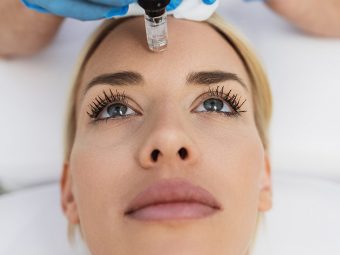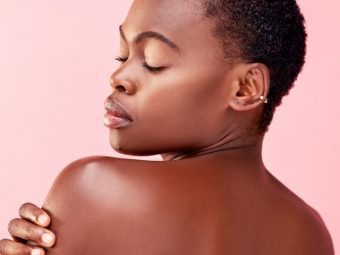7 Ways To Get Rid Of Pitted Acne Scars | Causes And Types
Minimize the appearance of those hollow scars on your face with simple natural treatments.

Acne is one of the most common skin problems that affect 80% of people between the ages 11 and 30 (1). Acne breakouts often leave indented scars, known as pitted acne scars. People often find it difficult to get rid of pitted acne scars, and they usually do not fade easily.
However, there are several treatment options that may help reduce the appearance of pitted acne scars. But are they safe? What about the cost? This article answers your queries and discusses a list of treatment options available to manage pitted acne scars. Keep reading!
In This Article
What Are Pitted Acne Scars?
Pitted acne scars are also called atrophic acne scars. They are the hollow, indented marks formed on the skin after a severe acne breakout. They look sunken compared to the other areas of the skin. They affect the skin’s texture and may become permanent if not treated soon. They are caused by a sudden loss of collagen that occurs during the skin healing process.
But what causes pitted acne scars? Keep reading to know.
What Causes Pitted Acne Scars?
Pitted scars are often associated with acne, chickenpox, surgery, or accidents (2). They are formed when the underlying structures that support the skin are lost. Inflammation damages the skin after a severe acne breakout – and the skin needs to produce new collagen and tissues to heal. However, skin inflammation affects the production of both melanin and collagen. This collagen shortage leads to skin scarring (2). It pulls the skin down and forms depressed atrophic scars. Similarly, melanin, if produced excessively, causes hyperpigmentation (3).
The lack of collagen production during the skin’s healing process may cause pitted acne scars. These scars can occur in different types. We have discussed the same below.
Types Of Pitted Acne Scars
The pitted acne scars are categorized based on their appearance. The three main types are:
- Boxcar Scars: These are broad scars with sharp depressions on your skin. They have well-defined edges. A chicken-pox scar can be a boxcar scar.
- Icepick Scars: These are tiny, narrow, deep holes – unlike boxcar scars. They go deep into the skin and appear like have been made from a tiny icepick.
- Rolling Scars: These are the widest of the three scars and have smooth, undulating edges. Their depths may vary and they make the skin look uneven.
Pitted acne scars can dent your confidence and leave you searching for ways to find out remedies. In the next section, we discuss a list of treatment options to get rid of these scars.
How To Get Rid Of Pitted Acne Scars?
- Laser Resurfacing
Laser resurfacing is done in two ways: ablative and non-ablative. The ablative laser removes a small piece of skin to reveal a smoother texture.
The non-ablative laser induces heat and collagen production. The laser causes damage to initiate the wound-healing process. It also stimulates the dermal fibroblasts to replace lost collagen and elastin (1). Laser resurfacing is a non-invasive, quick treatment that warrants 6 to 8 sessions.
- Dermabrasion
The epidermis is removed to remodel the skin’s structural proteins in the reticular dermis (thick bottom layer of the dermis). This process reorganizes the papillary dermal collagen without causing any injury to the reticular dermis. This is best suited for treating rolling scars or boxcar scars (4). However, this treatment may increase the risk of sun sensitivity and photodamage. Hence, protect your skin after the treatment to prevent hyperpigmentation.
- Chemical Peeling
Chemicals applied to the skin exfoliate (to remove dead skin cells) the top layer to minimize scarring and reveal fresher skin beneath. It is a controlled procedure that boosts collagen production around the scars. Different chemicals have different penetration levels. The chemicals used and their concentration depends on the type of scarring. Glycolic acid and salicylic acid are the most commonly used peeling agents (5).
The combinations of retinaldehyde with glycolic acid and retinoic acid with glycolic acid may also help reduce pitted acne scars (6), (7).
- Microneedling With Radiofrequency
Radiofrequency energy is used to tighten the skin and minimize the visibility of pitted acne scars. Microneedling involves repairing the skin by causing injuries to boost collagen production. When combined with radiofrequency, the energy is released deeper into the skin. It triggers a bigger inflammatory response and remodels the dermal collagen (5). This procedure is one of the effective techniques for treating indented scarring with minimal side effects.
- Fillers
This procedure involves filling pitted acne scars to achieve even-looking skin. The fillers augment the soft tissue. Hyaluronic acid is the commonly used filler (8). It adds volume to the scar and has no downtime. However, it only provides a temporary solution as the body enzymes digest the fillers over time.
- Subcision
Subcision involves inserting a needle under the acne scar and breaking up the collagen cord. When the fibrous component below the dermis is cut, the scar elevates and produces new collagen. Multiple sessions are required to achieve the desired results. The procedure is more effective in improving rolling scars. Combining subcision with other scar revision procedures may provide better results (9).
- Punch Techniques
These include three types:
I) Punch Excision: The scar is cut out and stitched together to make a less visible scar. It is preferred for icepick scars and boxcar scars.
II) Punch Grafting: The scar is removed and replaced with skin from elsewhere. It is preferred for reducing icepick scars. It warrants 20 or more replacement grafts in a single session.
III) Punch Elevation: The scar is cut out. The tissue is then elevated and sutured at a slightly higher level than the surrounding skin. This procedure is preferred for reducing boxcar scars (5).
These treatments can minimize pitted acne scars. However, preventing the scars is always preferable.
Another treatment that can help is platelet rich plasma therapy (PRP), also called vampire facelift/facial. Here, platelet-rich plasma (fibroblasts, epidermal growth factors) is injected into acne scars subdermal with microneedling, giving excellent results.
In addition to topical treatments, oral supplements of collagen sachets also enhances the outcome of the treatments.
Ways To Prevent Pitted Acne Scars
- Early treatment of active acne is the best solution to prevent pitted acne scars. If you have acne-prone skin or an acne breakout, avoid picking skin or popping the acne. Squeezing can inflame your skin and lead to scarring.
- Use oil-free sunscreen every day. Excess sun exposure may damage the skin and reduce collagen. Use sunscreen with at least SPF 30 to prevent collagen loss and pitted acne scars.
- Exfoliate the skin to prevent the clogging of pores. Exfoliation also helps increase skin cell turnover and prevents breakouts. It also removes dead cells from the skin surface and reduces the visibility of scars.
- Hydrate the skin to make it smooth and minimize the appearance of pitted acne scars. Dehydrated skin highlights the irregularities on the skin.
- Choose skincare products with vitamin C, retinol, or alpha hydroxy acids to boost collagen production.
Summing It Up
Pitted acne scars are the indented scars caused by severe acne breakouts. They mainly result from the sudden loss of collagen and damage caused by acne inflammation. Several treatments like retinoids, glycolic acid, laser resurfacing, subcision, dermabrasion, chemical peeling, etc., help reduce the appearance of scars. However, since you cannot completely get rid of pitted acne scars, it is always best to take preventive measures to minimize scarring. Following a proper skin care routine and treating acne breakouts on time will help prevent pitted acne scars.
Frequently Asked Questions
Does niacinamide help with pitted acne scars?
No. Niacinamide may help reduce post-acne marks and improve skin texture. However, it may not improve the appearance of deep and pitted acne scars.
What is better for pitted acne scars, microneedling or laser?
Both are effective in improving the appearance of pitted scars. Microneedling is less expensive than laser therapy and has a shorter downtime. However, laser therapy may provide long-lasting results.
What is better for pitted acne scars, microdermabrasion or microneedling?
Both treatments yield similar results using different techniques to treat pitted acne scars. While microdermabrasion is a safer procedure that exfoliates the top layer of the skin, microneedling works at deeper levels to boost collagen production and provide lasting results.
Key Takeaways
- Pitted acne scars may leave your face looking uneven and spotted.
- Chemical peeling, laser resurfacing, microneedling, and dermabarasion are a few of the may options that help reduce the appearance of pitted acne scars.
- Keeping your skin exfoliated, well- moisturized, sun-protected, and acne-free can help prevent the development of pitted acne scars.
Sources
Articles on StyleCraze are backed by verified information from peer-reviewed and academic research papers, reputed organizations, research institutions, and medical associations to ensure accuracy and relevance. Read our editorial policy to learn more.
- Acne Scarring—Pathogenesis Evaluation and Treatment Options
https://www.ncbi.nlm.nih.gov/labs/pmc/articles/PMC5749614/ - Extracellular Matrix Reorganization During Wound Healing and Its Impact on Abnormal Scarring
https://www.ncbi.nlm.nih.gov/labs/pmc/articles/PMC4352699/ - Postinflammatory Hyperpigmentation
https://www.ncbi.nlm.nih.gov/labs/pmc/articles/PMC2921758/ - Treatment of acne scarring
https://pubmed.ncbi.nlm.nih.gov/11594674/ - Effective Treatments of Atrophic Acne Scars
https://www.ncbi.nlm.nih.gov/labs/pmc/articles/PMC4445894/ - Retinoic acid and glycolic acid combination in the treatment of acne scars
https://www.ncbi.nlm.nih.gov/labs/pmc/articles/PMC4375771/ - Combined 0.1% retinaldehyde/ 6% glycolic acid cream in prophylaxis and treatment of acne scarring
https://pubmed.ncbi.nlm.nih.gov/17377389/ - Fillers for the improvement in acne scars Fillers for the improvement in acne scars – PMC (nih.gov)
https://www.ncbi.nlm.nih.gov/labs/pmc/articles/PMC4598204/ - Subcision for acne scarring: technique and outcomes in 40 patients
https://pubmed.ncbi.nlm.nih.gov/15841633/












